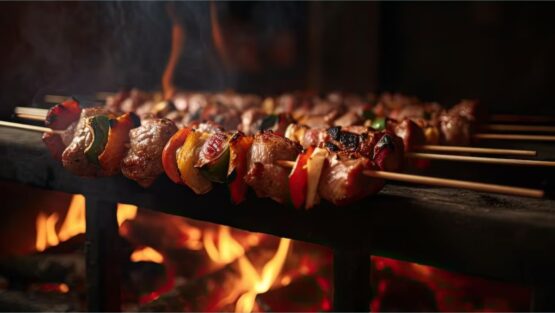- You have no items in your shopping cart
- Continue Shopping



What’s better than steak hitting the coals as rain drops touch the earth, what with friends, family, a well-stocked bar and BBQ smoke surrounding you! Now, here are some great tips to make sure your barbecue packs the punch.
1. Handy Tools
Keeping a few tools at hand will go a long way in making your barbeque a piece of steak!
A long handled pair of tongs make moving heavier cuts easy and safe.
A temperature probe is a great investment for outdoor cooking as it can be harder to tell if meat is cooked through.
Make your own herb brush to add extra flavour by gathering your chosen herbs (like rosemary, thyme, parsley or whatever suits your taste) and attach them to the end of a wooden spoon with some twine. Simply dip the herbs in some olive oil and brush over your meats before grilling.
Barbecue gloves, being heat resistant, keep your hands safe from the flames so you can move hot pans and food or even rearrange the coals.
2. Marinate that meat
Inject some instant flavour into your cuts by marinating them. Marinating overnight is the best way to ensure the flavours permeate the meat. Don’t forget to shake off any excess marinade before the meat hits the grill, especially if it contains oil. If it’s too saucy the meat is more likely to burn or flare causing that bitter smoky flavour.
3. Avoid fridge chill
Taking the raw meat or fish out of the fridge at least 20 minutes before barbecuing gives it long enough to lose its chill and get down to room temperature. If the meat is too cold when it hits the grill there’s a danger it could burn on the outside before it’s cooked through to the middle. This is especially important with chicken, sausages and any other pork for obvious reasons. It’s still important to do this with beef burgers and steaks to ensure your meat is as rare or well done as you like it.
4. Choosing your charcoal
Charcoal choice is important. Lump charcoal is fast lighting, a good choice if you’re cooking a wide range of meat. Briquettes on the other hand can burn at a consistent temperature, making them ideal for grilling roasting joints.


 5. Direct and Indirect Cooking Methods
5. Direct and Indirect Cooking Methods
Direct cooking is the most common method on the barbecue. It’s great for thin cuts like steaks, burgers, fish and sausages as they’re placed directly over the heat. One of the main advantages of direct cooking is the high temperatures within the barbecue create the perfect conditions for searing, resulting in great flavour and texture to the meat.
Indirect cooking methods are a little more advanced than direct cooking. Place the meat next to, not directly over, the heat source. Once they’re warm separate your coals into two piles at opposite ends of the grill. Place a drip tray underneath the grill, between the coals. Your meat goes on the grill in the space over the drip tray. With this method the barbecue acts like an oven so is ideal for cuts like roasting joints that require slow cooking on a lower heat.
6. Test the meat
An obvious one but so important, especially if you’re cooking for a lot of people. It can be hard to tell how well-done meat is on the barbecue by sight alone. Be sure to cut into chicken and pork and check whether the juices run clear, or invest in a temperature probe.
7. Rest the meat
Once the meat is cooked to your liking it’s a good idea to rest it for a few minutes. This allows it to reabsorb its juices and become more tender. A good idea is to rest it on a warmed, foil covered tray on the top rack of the BBQ, away from direct heat. The bigger the cut, the longer you rest it.
Happy barbecuing!

